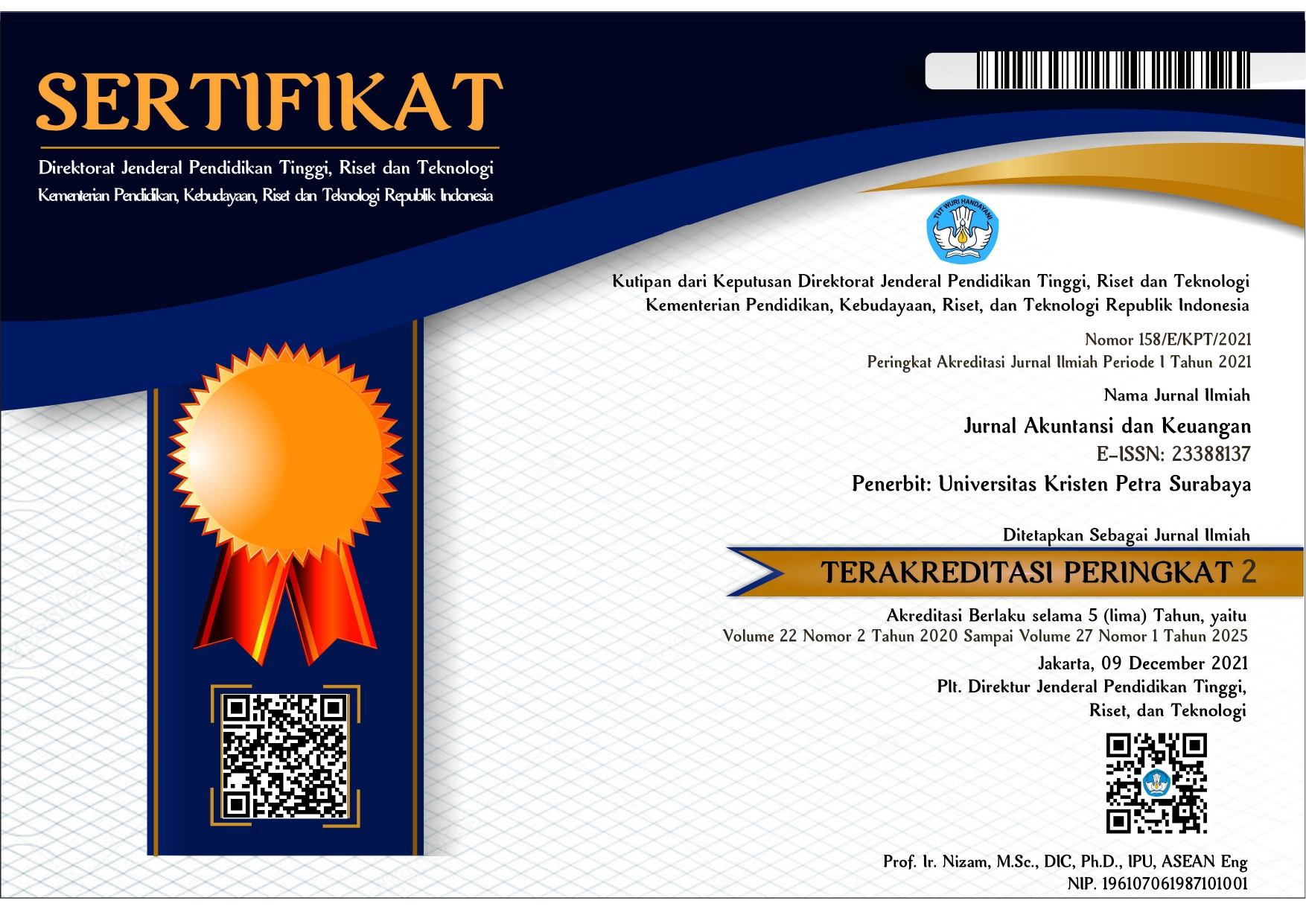Laba dan Arus Kas dalam Memprediksi Laba dan Arus Kas Masa Mendatang dan Pola Harga Saham
DOI:
https://doi.org/10.9744/jak.17.2.97-107Keywords:
Earnings, cash flows, stock prices, ARIMA model, prediction.Abstract
This study aims to test empirically the ability of earnings and cash flows in predicting future earnings and cash flows and stock prices fluctuation pattern. The samples of the research are drawn by using purposive sampling from manufacturing companies listed in Indonesian Stock Exchange. The results of data analysis using Autoregressive Integrated Moving Average (ARIMA) model show that four of five hypothesis are supported. It means that earnings are able to predict future earning and stock price fluctuation pattern, current stock prices can predict future earning price and the series of cash flows can predict future cash flows. However, the fifth hypothesis stated that cash flows can predict stock prices pattern cannot be proved.References
Andayani, W., Junaidi, and Nurdiono. (2011), Annual earnings analysis with ARIMA for future earnings prediction, Journal of Modern Accounting and Auditing, 7(6), 645-651.
Ball, R. and Brown, P. (1968), An Empirical Evaluation of Accounting Income Numbers, Journal of Accounting Research, 159-178.
------ and R. Watts (1972), Some Time Series Properties of Accounting Income, Journal of Finance, 663-682.
Baridwan, Z. (2004), Intermediate Accounting, Edisi 8, BPFE, Yogyakarta.
------- (1997), Analisis Tambahan Informasi Laporan Arus Kas, Jurnal Ekonomi dan Bisnis Indonesia, 12, 113.
Victor, B, L. and Stober, T. L. (1989), The Nature and Amount of Information in Cash Flows and Accrual, The Accounting Review, 624-652.
Bowen, R. M., Burgstahler, D., and Daley, L.A. (1986), The Evidence on The Relationship Between Earnings and Various Measures of Cash Flow from Operation, The Accounting Review (LXI), 4, 713.
Beaver, W. H. (1970), The Time Series Behavior of Earnings, Supplement to Journal of Accounting Research, page 62-69.
Brown, L. D. (1993), Earnings Forecast Research: Its Implications for Capital Market Research, International and Business Research, 14, Spring, 113-124.
Fairfield, P. M., Sweeney, R. J., and Yohn, T. L. (1996), Accounting Classification and The Predictive Content of Earnings, The Accounting Review, 71(3), 337-355.
Febriyanti, G. A. (2004), Perbandingan Keakuratan Model Laba Permanen, Transitori dan Laba Agregat dalam Memprediksi Laba Masa Depan, Proceeding, SNA VII, Bali.
Finger, C. A. (1994), The Ability of Earnings to Predict Future Cash Flow, Journal of Accounting Research, 32(32), Autumn, 210-223.
Foster, George (1986), Financial Statement Analysis, Second Edition, Prentice-Hall International.
----------- (1977a), Quarterly Accounting Data: Time-series Properties and Predictive-Ability Result, Accounting Review, page 1-21.
Hendriksen, E. S. and van Breda (1991), Accounting Theory, Fifth Edition, Irwin United State of America.
Hermawan, A. dan Hadyansah, N. (2002), Analisa Pengaruh Format Metode Langsung Dalam Laporan Arus Kas Terhadap Return Saham, Proceeding, Simposium Nasional Akuntansi, September, 102-110.
Ismail, B. E. and Kim, M. A (1989). On The Association of Cash Flows Variables with Market Risk: Further Evidence, The Accounting Review, January, 125-136.
Ikatan Akuntan Indonesia (2009), Standar Akuntansi Keuangan, Jakarta, Devisi Penerbitan IAI.
Isgiyarta, J. (1997), Klasifikasi Akuntansi dan Kemampuan Prediksi Laba, Tesis S2, Tidak Dipublikasikan, Universitas Gadjah Mada.
Junaidi (2011), Earnings Performance in Predicting Future Earnings And Stock Price Pattern. Journal of Economics, Business, & Accountancy (Ventura), 14(2), 107-112.
Kieso, D. E., Weygandt, J. J., and Warfield, T. D. (2011), Intermediate Accounting, volume 1, John Willey & Son, USA.
Kholidiah (2002), Perbandingan Keakuratan Metode Naïve, Regresi Sederhana & Box-Jenkins, Tesis S2, Tidak Dipublikasikan, Universitas Gadjah Mada, Yogyakarta.
Kusuma, Poppy, D. I. (2003), Nilai Tambah Kandungan Informasi Laba dan Arus Kas Operasi, Proceeding, Simposium Nasional Akuntansi (SNA) VI, Surabaya, 304-313.
Kuncoro, Mudrajad (2001), Metode Kuantitatif: Teori dan Aplikasi untuk Bisnis dan Ekonomi, Edisi pertama, UPP AMP YKPN, Yogyakarta.
Lipe R. C., (1986), The Information Contained in The Components of Earnings, Journal of Accounting Research, 24, Supplement, 37-64.
Parawiyati, dan Baridwan, Z. (1998), Kemampuan Laba dan Arus Kas dalam Memprediksi Laba dan Arus Kas Perusahaan Go Publik di Indonesia, Jurnal Riset Akuntansi Indonesia, 1-11.
Rayburn, J. (1986). The Association of Operating Cash Flow and Accrual with Security Returns, Journal of Accounting Research (Supplement), 112-133
Sugiri, S. (2003), Kemampuan Laba Rincian untuk Memprediksi Arus Kas, Desertasi, Tidak Dipublikasikan, Universitas Gadjah Mada, Yogyakarta.
Supriyadi (1999), The Perdictive Ability of Earnings Versus Cash Flow Data to Predict Future Cash Flows: A Firm Specific Analysis, Gadjah Mada International Journal of Business, 1(2), 113-132.
Sunariyah (1996), Ketepatan Ramalan Laba di Prospektus Pada Awal Penawaraan Umum di Pasar Modal Indonesia, Tesis S2, Tidak Dipublikasikan, Universitas Gadjah Mada, Yogyakarta.
Utami, C. D. (1999), Muatan Informasi Arus Kas dari Aktivitas Operasi, Investasi, dan Pendanaan, Jurnal Bisnis dan Akuntansi, 1, 15-27.
Sri, W. (2000), Pengaruh Klasifikasi Komponen Laba terhadap Kemampuan Prediksi Laba, Tesis S2, Universitas Gadjah Mada, Yogyakarta.
Downloads
Published
How to Cite
Issue
Section
License
Authors who publish with this journal agree to the following terms:
- Authors retain the copyright and publishing right, and grant the journal right of first publication with the work simultaneously licensed under a Creative Commons Attribution License that allows others to share the work with an acknowledgement of the work's authorship and initial publication in this journal.
- Authors are able to enter into separate, additional contractual arrangements for the non-exclusive distribution of the journal's published version of the work (e.g., post it to an institutional repository or publish it in a book), with an acknowledgement of its initial publication in this journal.
- Authors are permitted and encouraged to post their work online (e.g., in institutional repositories or on their website) followingthe publication of the article, as it can lead to productive exchanges, as well as earlier and greater citation of published work (See The Effect of Open Access).<a href="http://creativecommons.org/lice














